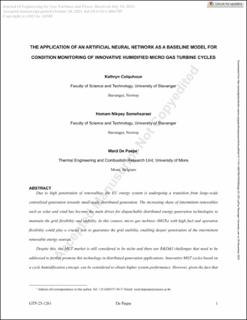| dc.contributor.author | Colquhoun, Kathryn | |
| dc.contributor.author | Nikpey Somehsaraei, Homam | |
| dc.contributor.author | De Paepe, Ward | |
| dc.date.accessioned | 2023-12-29T13:05:59Z | |
| dc.date.available | 2023-12-29T13:05:59Z | |
| dc.date.created | 2023-11-20T09:55:34Z | |
| dc.date.issued | 2023 | |
| dc.identifier.citation | Colquhoun, K., Nikpey Somehsaraei, H. & De Papepe, W. (2023) The Application of an Artificial Neural Network as a Baseline Model for Condition Monitoring of Innovative Humidified Micro Gas Turbine Cycles. Journal of Engineering For Gas Turbines and Power, | en_US |
| dc.identifier.issn | 0742-4795 | |
| dc.identifier.uri | https://hdl.handle.net/11250/3109156 | |
| dc.description.abstract | Due to high penetration of renewables, the EU energy system is undergoing a transition from large-scale centralized generation toward small-scale distributed generation. The increasing share of intermittent renewables such as solar and wind has become the main driver for dispatchable distributed energy generation technologies to maintain the grid flexibility and stability. In this context, micro gas turbines (MGTs) with high fuel and operation flexibility could play a crucial role to guarantee the grid stability, enabling deeper penetration of the intermittent renewable energy sources. Despite this, the MGT market is still considered to be niche, and there are R&D&I challenges that need to be addressed to further promote this technology in distributed generation applications. Innovative MGT cycles based on a cycle humidification concept can be considered to obtain higher system performance. However, given the fact that MGTs are installed close to the consumption points, where they are operated by nontechnical prosumers with very limited access to maintenance services, they should also offer high availability and reliability to avoid unexpected outages and secure the supply. Therefore, intelligent monitoring systems are needed that can support nonexpert end-users to detect degradation and plan maintenance before a breakdown occurs. In this study, we investigated and developed advanced methods based on artificial neural networks (ANNs) for condition monitoring of a humidified MGT cycle under real-life operational conditions. To create a high-performing model, extensive data preprocessing has been conducted to remove data outliers and select optimum model features, which provide best results. Additionally, the model hyperparameters such as learning rate, momentum, and number of hidden nodes have been altered to achieve the most accurate predictions. The results of this study have provided a baseline ANN model capable of conducting condition monitoring of a micro humid air turbine (mHAT) system, which will be applied to additional studies in the future. | en_US |
| dc.language.iso | eng | en_US |
| dc.publisher | American Society of Mechanical Engineers | en_US |
| dc.rights | Navngivelse 4.0 Internasjonal | * |
| dc.rights.uri | http://creativecommons.org/licenses/by/4.0/deed.no | * |
| dc.subject | ANN | en_US |
| dc.subject | nevrale nettverk | en_US |
| dc.title | The Application of an Artificial Neural Network as a Baseline Model for Condition Monitoring of Innovative Humidified Micro Gas Turbine Cycles | en_US |
| dc.type | Peer reviewed | en_US |
| dc.type | Journal article | en_US |
| dc.description.version | acceptedVersion | en_US |
| dc.rights.holder | © 2023 ASME | en_US |
| dc.subject.nsi | VDP::Teknologi: 500 | en_US |
| dc.source.journal | Journal of Engineering For Gas Turbines and Power | en_US |
| dc.identifier.doi | 10.1115/1.4063785 | |
| dc.identifier.cristin | 2198636 | |
| dc.source.articlenumber | GTP-23-1261 | en_US |
| cristin.ispublished | true | |
| cristin.fulltext | original | |
| cristin.qualitycode | 1 | |

